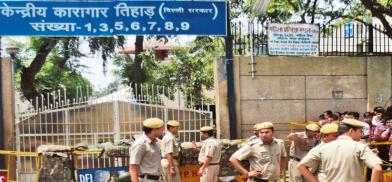Is 'temporary' release of prisoners enough to halt spread of COVID-19?
In South Asia, India has, on the directives of its Supreme Court, constituted High Powered Committees in each state to define criteria for release of both sentenced and unsentenced prisoners, writes Madhurima Dhanuka for the South Asia Monitor

These are unprecedented times. The world, as we know it, has dramatically – and perhaps irrevocably -- changed. The liberties we cherished and enjoyed no longer remain unfettered. A pandemic has caught the world unawares and left it struggling. While countries have offered vastly differing responses to the pandemic, it has been heartening although surprising to see the attention that countries and international institutions have given to the incarcerated.
Prisons which usually have come at the bottom of government priorities have suddenly risen to among the top concerns. Issues of overcrowding and inadequate healthcare in prisons, hitherto neglected by governments have become mainstream discussions. Nations are scrambling to reduce the number of persons in detention, with calls from several international organisations, local groups, experts, lawyers and human rights defenders to suspend arrests, reduce the use of pre-trial detention for low-level offences, release elderly inmates among other steps. These have been recently endorsed by the UN High Commissioner for Human Rights, Michelle Bachelet who has urged governments to act quickly to reduce the number of people in detention.
What is further surprising, and pleasantly so, is that governments have actually heeded these calls, and taken steps to reduce their prison populations. Iran has reportedly released over 70,000 prisoners, whereas countries like the UK, the US and Canada announced plans to release thousands of prisoners.
In South Asia, India has, on the directives of its Supreme Court, constituted High Powered Committees in each state to define criteria for release of both sentenced and unsentenced prisoners. Several Indian states have already announced the release of thousands of prisoners. Assam has freed over 700 persons.
Similarly, Sri Lanka too has announced the constitution of a committee to consider releases of prisoners, whereas Bangladesh is planning to release some 3,000 prisoners who are charged with bailable offences.
While all of this sounds promising, there are some fundamental concerns which remain unaddressed, unanswered and even undiscussed.
Firstly, overcrowding is an old problem. Prison populations and use of pre-trial detention has grown immensely across the world, leading to overcrowded prisons in several jurisdictions. Why is it only now that the judiciary has realised the grave problems posed by such overcrowding?
COVID-19 isn’t the only contagion that can afflict prison populations. Communicable diseases are of particular concern, with research evidencing that infection rates for tuberculosis are between 10 to 100 times higher than in the community, and prisoners are five times more likely to be living with HIV than adults in the general population.
Overcrowded prisons coupled with poor sanitary conditions also increase the chances of skin/bacterial/fungal and parasitic diseases, which can quickly spread across prison populations. Thus, overcrowded prisons are a risk to prison populations at all times, irrespective of a virus.
Secondly, these releases termed as ‘interim bail’ or’ short-term parole’ are temporary in nature. This raises a few key questions – if a person is fit to be released on bail now, and then wasn’t s/he granted bail earlier? What necessitates her/his pre-trial detention at all? For sentenced prisoners released on short-term parole, why not just commute their sentences for good? The larger question to ask here is why there is such focus on temporary relief and not a long-term solution to mitigate if not end overcrowding?
Thirdly, releasing a few thousand prisoners does not address other major challenges viz. inadequate health care services in prisons. Consider a prison with a population of 100 prisoners but which has an actual capacity of 50. A decision to release 50 prisoners will have no impact on the possibility that the remaining 50 could be infected by the virus.
An underfunded and understaffed prison system with low standards of healthcare provisioning can enable the ongoing COVID-19 crisis to impact prisoners, irrespective of the number in detention.
It would have been more definitive if countries had been urged to improve healthcare facilities in prisons. Efforts to ensure that proper precautions are followed, amenities provided and hygiene levels maintained would probably have been a far more long-term, sustainable and effective strategy in addressing concerns of the spread of the virus in prisons.
A bigger question, inherent to criminal justice principles, lies in balancing the rights of victims when considering the release of prisoners. Can one ignore the possible dangers to victims and the society that are associated with the release of many pre-trial and convicted prisoners? Are such hasty releases, a complete disregard of victim’s rights and interests?
Time will tell whether the release of prisoners was effective in halting the spread of COVID-19 in prisons.
However, it is quite likely that the ‘temporary’ nature of these releases may have no long-term positive impact on reducing overcrowding, improving healthcare or ensuring that basic minimum standards for humanely treating prisoners are followed worldwide.
A robust approach, founded in efforts to improve healthcare systems within prisons, may have been far more sustainable and long-lasting. Unfortunately, it is quite possible, that in two to three months from now, when the ‘temporary’ release of prisoners end, prisons worldwide would go back to being their ‘normal’ dingy, dirty, overcrowded selves, falling back into the low priority lists of governments the world over.
(The writer is Programme Head, Prison Reforms Programme, Commonwealth Human Rights Initiative (CHRI))









Post a Comment